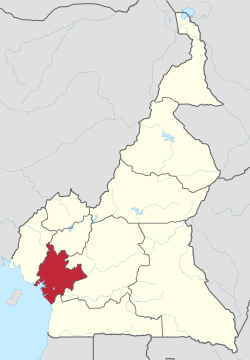The Littoral Region of Cameroon has as capital city Douala, the Country’s economic capital. The Littoral Region (French: Région du Littoral) is divided into four regions:
- Moungo, with its capital at Nkongsamba.
- Nkam, with its capital at Yabassi.
- Sanaga-Maritime, with its capital at Édéa.
- Wouri, forming the area around the major city of Douala.
| Government | |
|---|---|
| • Governor | Samuel Ivaha Diboua (2015– ) |
| Area |
|
| • Total | 20,248 km2 (7,818 sq mi) |
| Population
(2015)
|
|
| • Total | 3,354,978 |
| • Density | 170/km2 (430/sq mi) |

With respect to tourism, the Littoral Region has several tourist endowments. The coaster zone, favourable to beach tourism, has picturesque bays, beautiful fine sand beaches which extend as far as your eyes can see, notably the Yoyo and Manoka beaches.
It has an equatorial climate with two variants, the variant with the Guinean type of climate is characterised by a fairly abundant rainfall; the variant with the Cameroonian type of climate is characterised by very strong rainfall.
The region is found very close to the sea, on the left shore of the River Wouri. The city of Douala, the Littoral Regional capital and economic capital of Cameroon is the main entry port of the country. It is a city that is full of activities thanks to its port (one of the most important in the West African coast) and its international airport, served by several air companies.
The principal rivers of the region are the Wouri, Sanaga, and Dibamba. They have abundant species of animals and plants and also serve as transportation means of goods and persons, and for the production of electrical energy.
- BUSINESS AND CONGRESS TOURISM
Business and congress tourism is well developed in Douala. Each year, it receives hundreds of tourists each year who come generally for seminars and conferences.
- ECOTOURISM
The Littoral Region is a zone that is endowed with several natural sites which are favourable for ecotourism.
- THE EKOM – NKAM WATERFALLS
Found between Melong and Nkongsamba, at an altitude of 80 meters, the Ekom – Nkam waterfalls featured a spectacular magnificent and impressive fall. It served as the background where some scenes of the “Greystoke, the legend of Tarzan” film, interpreted by Christopher Lambert was shot.
- THE DIBOMBE WATERFALLS
It flows from the Dibombe River which crosses the town of Manjo at 100 meters at the upper section of the Wouri Bridge.
- THE NGOG – LITUBA CAVE
It is found at 80 km from Edea. This cave has 800 meters of altitude on a hill of 1 500 meters with a natural vegetation cover anchored on a rock.
- THE DOUALA – EDEA WILDLIFE RESERVE
It is very rich in forest resources. Together with the Yoyo beaches, they constitute the natural resources that Cameroon seeks to conserve. It has a variety of animal species such as elephants, antelopes, phacocheres, pythons, crocodiles, iguanes, and endemic species such as Manatees.
- BEACH TOURISM
The Littoral Region is endowed with beautiful fine sand beaches such as the Yoyo and Manoka beaches as well as the Lake Ossa beaches at the Sanaga Maritime Division.
- TREKKING AND WALKING
The Manenguba Mountains in the locality of Melong offer very interesting trekking and walking possibilities all along the slopes of these mountains. At the summit of these mountains, we have Male and Female lakes. The Female Lake, with its blue waters presents itself in the form of an inverted African map, and it is more accessible since it is situated on top of a hill. On the other hand, the Male Lake, with its green colour waters, is found embedded in between two hills, making its access a little bit difficult.
- AGROTOURISM
Agritourism is well developed in this region thanks to the presence of large agro-industrial exploitations of pineapples, bananas, oil palms, etc., found in Douala and Edea.
- CULTURAL TOURISM – Littoral Region of Cameroon
It is manifested through artisanal, folklore, habitat, dressing modes, and culinary arts. Social and musical organisations are numerous in quarters such as New-Bell, Bassa, Akwa, Deido, Mbamewondo or Haoussa. Douala is the head-quarter of the Ngondo culture, the great Sawa traditional festival. The secondary towns organised colourful events such as the Mpo’o festival of Edea, and the Mbo’o folkloric dance of Nkongsamba.
- CITY TOUR OF DOUALA
- The Pagode of the Palace of King Manga Bell at Bonanjo, built-in 1905 by King Auguste Manga Ndoumbe, in the Nippon style. It is today the most famous monument in Douala. In 1908, Rudolf Douala Manga Bell succeeded his father at the helm of the chiefdom and was installed here.
- The Castel of Prince Dika at Akwa. It has all the representative monuments of the 10 regions of Cameroon.
- The Mosque at the Central Market. It is the first mosque built in Douala.
- The Mboppi, Deido, and Central markets. They are well furnished and colourful.
- The small marine building, near the Bonanjo post, which today serves as a Police Post. This is the place where King Rudolf Douala Manga Bell was hung.
- The military medical centre, the place where Rudolf Douala Manga Bell and Ngosso were detained on the eve of their hanging.
- The Akwa feasting hall, which served as the ancient customary court; was the place where the first plane landed in 1927, coming from French Equatorial Africa.
- The century church, the first Christian church of Douala, was built by the English missionary, Alfred Saker.
- The Bonaberi railway station, the first railway built in Douala.


